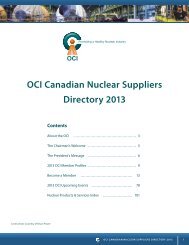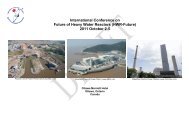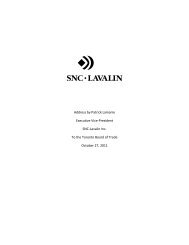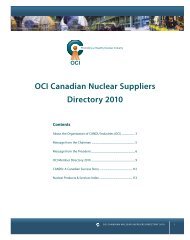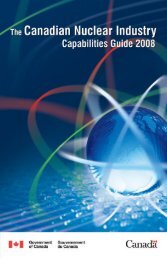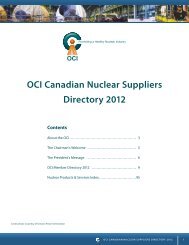CNA Nuclear Energy Handbook 2009 - Teach Nuclear
CNA Nuclear Energy Handbook 2009 - Teach Nuclear
CNA Nuclear Energy Handbook 2009 - Teach Nuclear
Create successful ePaper yourself
Turn your PDF publications into a flip-book with our unique Google optimized e-Paper software.
<strong>Nuclear</strong> Facts — Ontario<br />
• In 2008, electricity in Ontario was generated from nuclear (53%), hydro<br />
(24.1%), coal (14.5%), oil and gas (6.9%), wind (0.9%) and other<br />
alternative sources (0.6%) (Source: IESO, <strong>2009</strong>).<br />
• By 2020, Ontario will need to replace about 80% of its electrical generation<br />
(25,000 MW) because of growth in demand and aging plants, about half of<br />
which are nuclear.<br />
• Load growth1999-2008—Ontario’s electricity demand has increased from<br />
150 TWh to 159 TWh over the last 10 years. A 6% overall increase,<br />
approximately 0.6% per year (Source: Statistics Canada).<br />
• In 2008, Ontarians electricity consumption was 148.4 TWh, a decrease of<br />
4 TWh from 2007.<br />
• By 2015, by refurbishing or replacing existing nuclear capacity, Ontario will<br />
ensure 14,890 MW of electrical generating capacity.<br />
• Bruce Power is refurbishing Bruce A (ON) Units 1 & 2 (805 MW each) with a<br />
return to service date in 2010 and will refurbish Bruce A Units 3 & 4 upon<br />
completion of 1 & 2.<br />
• The top two performing nuclear reactors in Ontario in 2008 were:<br />
Darlington 3 (934 MW) with 99.4% performance and Darlington 2<br />
(934 MW) with 98.5% performance.<br />
• In June 2008, the Government of Ontario selected the Darlington <strong>Nuclear</strong><br />
Site as the location for new nuclear plant construction.<br />
Pickering, ON<br />
Darlington, ON<br />
10<br />
Bruce, ON



